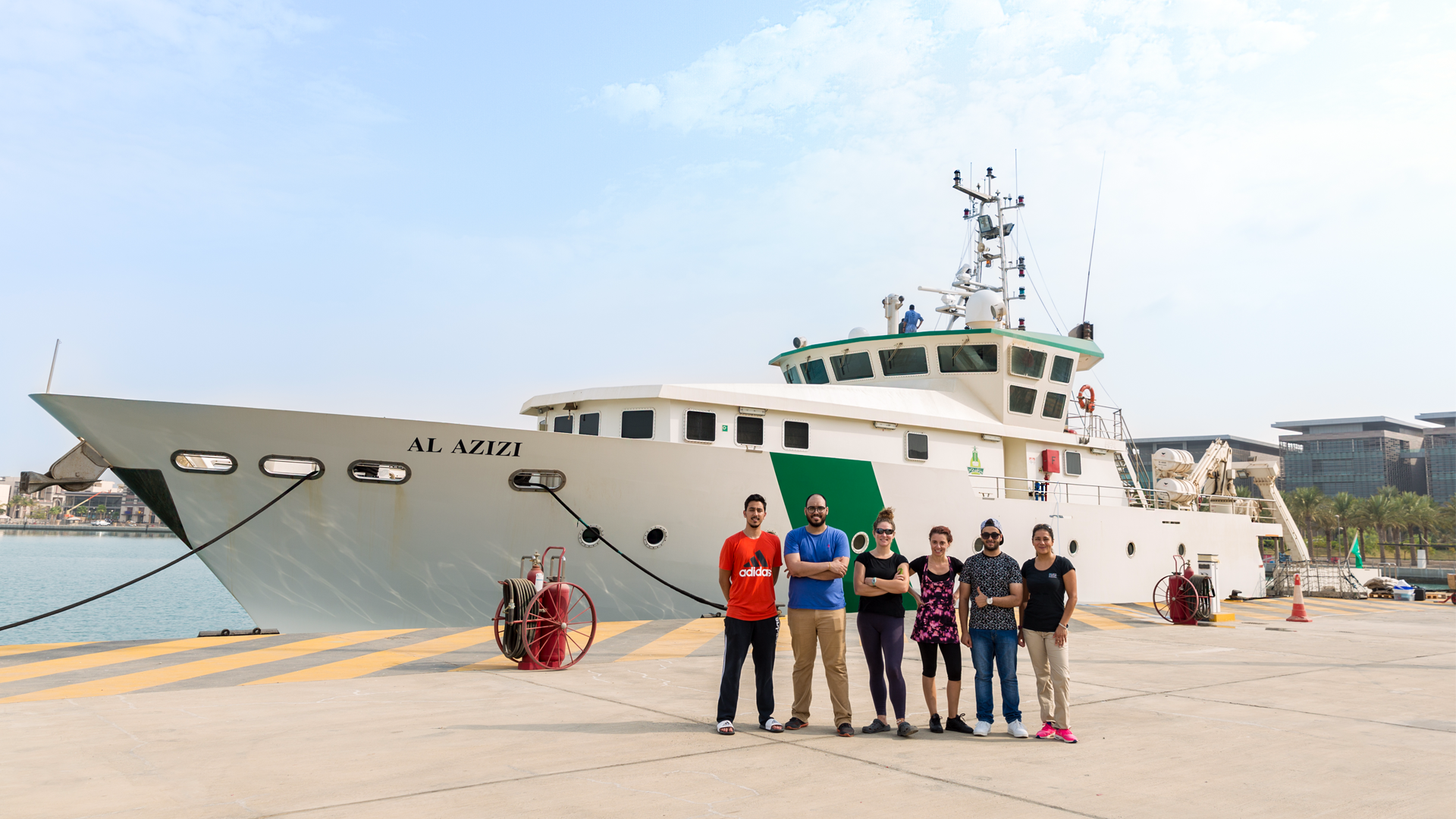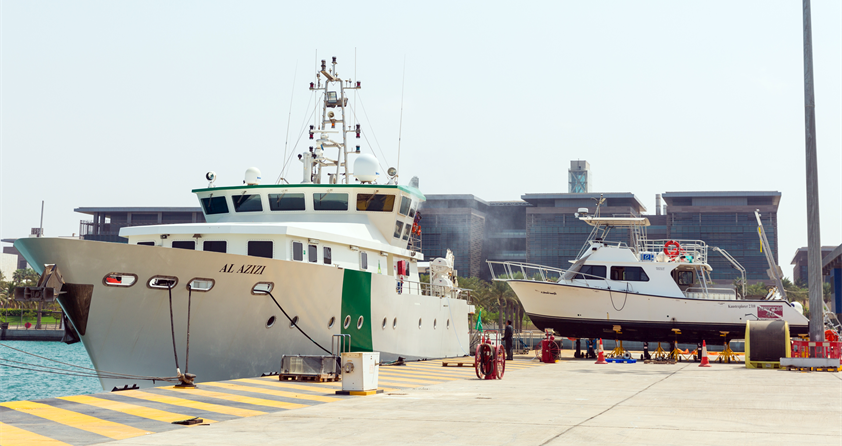By David Murphy and Lulwah Shalhoub, KAUST News
At 178 nautical miles wide and 1,187 nautical miles long, the Red Sea is not the world's largest body of water, and although heavily traversed by freight and tourist vessels alike, it is not particularly well understood. A collaborative team of multidisciplinary researchers from KAUST and King Abdulaziz University (KAU) recently set out to change that.
The team conducted a 16-day study of the Red Sea aboard the KAU research vessel the RV Al-Azizi. The research trip, which measured a pelagic transect of the entire Red Sea from north to south (including the numerous physical and biological parameters), featured eight KAUST researchers and three KAU researchers.
From August 1 to 17, researchers on board examined nutrient cycling, productivity, ecosystem health and biodiversity along the Economic Exclusive Zone of the Red Sea. The research was aimed at elucidating the north-south environmental gradients, which structure the ecosystems and their capacity to resist stresses. An additional goal of the trip was to describe for the first time how latitudinal changes in temperature and the amount and quality of dissolved organic matter impact the distribution and physiological characteristics of heterotrophic prokaryotes (planktonic bacteria and archaea)—the largest living biomass of the world's oceans.
The research was conducted as part of a Saudi Arabian contribution to the Second International Indian Ocean Expedition (IIOE-2), a multinational, multi-year initiative started by the IOC and UNESCO to further understanding of the Indian Ocean.
Proof of concept
The KAUST Coastal and Marine Resources Core Lab provided the logistical and technical expertise for the expedition. Lloyd Smith, the director of the Coastal and Marine Resources Core Lab, felt that the goal of the trip was twofold.
"It was primarily a scientific cruise to achieve the research goals of the KAUST Red Sea Research Center (RSRC) Center Competitive Fund (CCF) project," Smith said. "It was also a proof of concept on sharing resources between two Saudi universities. In this economic environment, it is much more sensible for universities to come together and share their resources rather than duplicate. By all accounts, both goals were achieved; however, from our perspective, the second was an outstanding success, with the ship successfully deployed with our people and equipment on board and all parties pleased with the way everyone and everything worked together."
"The trip was just the first of what we hope to be many joint cruises between KAU and KAUST," he added. "We intend to facilitate an arrangement whereby future cruises will be easier to initiate and manage for both parties. To reach the goals of Vision 2030, universities cannot operate in a vacuum. The only way the goals can be achieved in the current economic environment is to work together collaboratively."
A natural collaboration
Carlos M. Duarte, director of the RSRC and the Tarek Ahmed Juffali Research Chair in Red Sea Ecology, felt the expedition strengthened the collaborative bonds between KAUST and KAU.
"This collaboration is a natural one, as KAU hosts the only faculty of marine science in the Kingdom of Saudi Arabia and has a long record of research in the Red Sea. In addition, there are strong collaborative ties between KAU and KAUST/RSRC reflected in multiple jointly authored publications. In addition, we have complimentary capacities, with the University's unique Core Lab concept delivering advanced technical capacities to support marine research through the Coastal and Marine Resources Core Lab and KAU operating the largest and more modern research vessel in the Red Sea, the RV Al-Azizi. Conversations conducive to this collaborative research were initiated in 2014 before I joined KAUST and while I was a distinguished adjunct professor at KAU. They reached fruition with the new RSRC CCF project started in July of 2016," Duarte said.
"The Red Sea and its potential to support the transformation of the Kingdom envisaged under Vision 2030 depends on a healthy Red Sea ecosystem. Understanding the health status and resilience of the Red Sea ecosystem to stresses is key to ensure an adequate health status," he concluded.
Improving knowledge about the Red Sea
Xosé Anxelu Morán, associate professor of marine science in the University's Marine Biological and Environmental Science and Engineering (BESE) division, outlined the essential aims of the recent research outing.
"In terms of science, the researchers from KAUST and KAU on board collected samples and performed experiments in order to improve our knowledge about the strong latitudinal gradients along the Red Sea. The fact that highest temperatures—we should not forget that the Red Sea is the hottest among the deep marine basins in the world—coincided with the highest inorganic nutrients concentrations in its southern part makes it very interesting to sample this section because it is less studied than the middle and the north," Morán said.
"The information about the distribution, standing stocks and productivity of pelagic organisms—from planktonic bacteria to fishes—along the N-S gradient will be invaluable towards our better understanding of the functioning of this unique ecosystem. We will be generating novel and comprehensive data sets in a systematic way on many physicochemical and biological variables that have never been sampled before, with the aim of repeating this in different periods of the year," he added.
Day-to-day on the Al-Azizi
Anders Røstad, a marine biologist from the University's RSRC, was the onboard cruise leader during the trip. Røstad, who specializes in fish and zooplankton ecology with the use of scientific echo sounders, was in charge of the day-to-day activities and organization on the Al-Azizi.
"In my role, I had to make sure that the scientists onboard were satisfied and everyone was communicating on the boat. I made plans and tried to figure out solutions to any hitches that occurred. I spent a lot of my time on the bridge with the captain deciding where to go and monitoring general information, including the weather," he said."We were able to gather quite a bit of data and we are happy with what we have. The big challenge was getting used to the boat as it is the first time we have used it—we had to learn as we went."
Røstad also described the overarching goal of the extensive two-week study and described how this mutually beneficial collaboration will hopefully be the first of many between KAUST and KAU. A similar trip is planned for early next year to gather information on seasonal variations and to complete research activities that were not fully covered this time around.
"Basically, in the Red Sea, you have a gradient in temperature and salinity from north to south. We will use that gradient to measure the whole Red Sea to see the difference between a whole set of different parameters and fields, measuring each stage. We will end up with a full scan of everything that's there—from bacteria to the smallest animals you can think of to fish—basically on every station, and also the physical parameters like temperature, oxygen and salinity, and also currents," Røstad noted.


Many research cruise members were involved in the two-week study of the Red Sea aboard the King Abdulaziz University research vessel the Al-Azizi. Photo by Lilit Hovhannisyan.
'To reach a single goal'
Mohammed H. Aljahdali, assistant professor of microbiology at KAU, who is based in the faculty of marine sciences, marine geology department, was also present on the Al-Azizi. Aljahdali, who specializes in the study of phytoplankton species, said his role on board was to collect samples of phytoplankton, creatures so small that they cannot be seen by the naked eye.
Onboard, his team used a device that contains 12 tubes with each tube drawing water from different depths (vertically) in order to follow biodiversity from north to south at different depths.
"The north is more saline/saltier and less nutrient dense, so the sea diversity in the north is different from the south. We then take a sample of two liters of seawater and filter it with very fine filters called 'membrane filters.' These filters are stored and dried before being taken to the laboratory and used in a scanning electron microscope," he explained.
"We are eager to know the environmental impact on phytoplankton, which serve as the base of the aquatic food composition for fish and other marine organisms. Phytoplankton protect the marine environment. The amount of phytoplankton has an environmental connotation of the marine environment's richness in resources. If it is rich, what are the causes and why it is different from one area to another?" he noted.
Aljahdali added he felt the collaboration was extremely fruitful, as both universities' research of the Red Sea overlaps at various junctions.
"The RV Al-Azizi is now the link between both of us. It is a large ship and it is well equipped, which allows us to agree on one idea to reach a single goal," he concluded.

